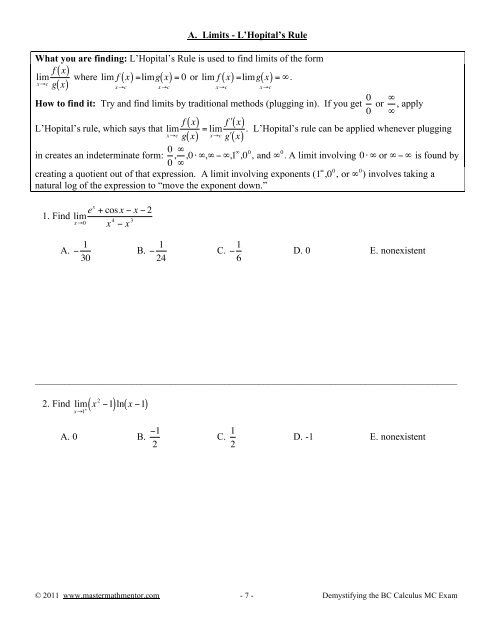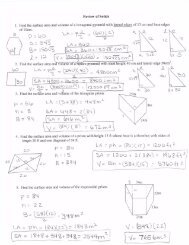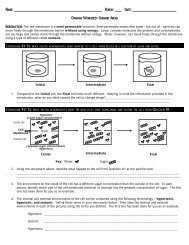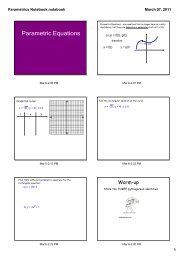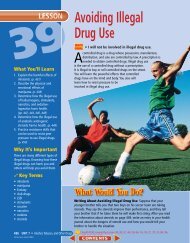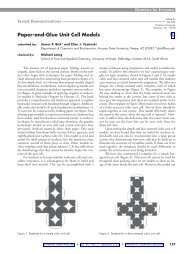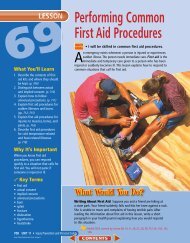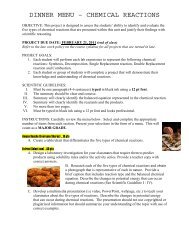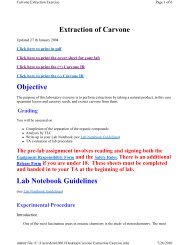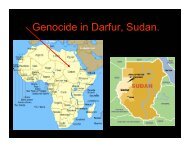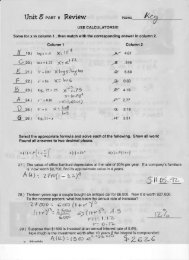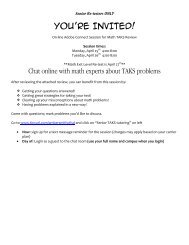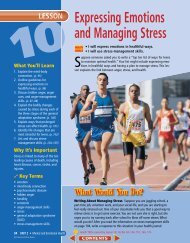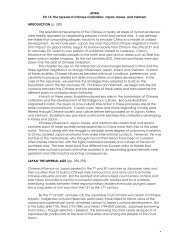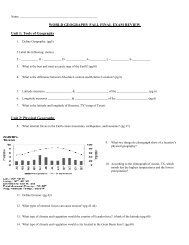x - Epsilen
x - Epsilen
x - Epsilen
You also want an ePaper? Increase the reach of your titles
YUMPU automatically turns print PDFs into web optimized ePapers that Google loves.
!<br />
A. Limits - L’Hopital’s Rule<br />
What you are finding: L’Hopital’s Rule is used to find limits of the form<br />
f ( x)<br />
lim where lim f ( x)<br />
= limg( x)<br />
= 0 or lim f ( x)<br />
= limg( x)<br />
= # .<br />
x "c g( x)<br />
x "c<br />
x "c<br />
x "c<br />
x "c<br />
0 "<br />
How to find it: Try and find limits by traditional methods (plugging in). If you get or<br />
0 "<br />
!<br />
, apply<br />
f ( x)<br />
f # ( x)<br />
L’Hopital’s rule, which says that lim = lim . L’Hopital’s rule can be applied whenever plugging<br />
x "c g( x)<br />
x "c g # ( x)<br />
0<br />
in creates an indeterminate form:<br />
0<br />
!<br />
!<br />
,"<br />
" ,0# "," $ ",1" ,0 0 , and " 0 . A limit involving 0" # or # $ # is found by<br />
creating a quotient out of that expression. A limit involving exponents ( 1<br />
!<br />
!<br />
" ,0 0 , or " 0 ) involves taking a<br />
natural log of the expression to “move the exponent down.”<br />
e<br />
1. Find lim<br />
x "0<br />
x + cos x # x # 2<br />
x 4 # x 3<br />
!<br />
A.<br />
" 1<br />
30<br />
!<br />
B.<br />
" 1<br />
24<br />
!<br />
C.<br />
" 1<br />
6<br />
D. 0 E. nonexistent<br />
_______________________________________________________________________________________<br />
!<br />
2. Find<br />
lim<br />
x "1 + x 2 ( #1)ln(<br />
x #1)<br />
A. 0 B.<br />
!<br />
"1<br />
2<br />
!<br />
C.<br />
1<br />
2<br />
D. -1 E. nonexistent<br />
© 2011 www.mastermathmentor.com - 7 - Demystifying the BC Calculus MC Exam
!<br />
!<br />
3. Find<br />
lim<br />
x "2<br />
e t 2 x<br />
#1<br />
$ dt<br />
2<br />
x 3 # 4x<br />
A. 0 B.<br />
!<br />
e 4<br />
12<br />
!<br />
C.<br />
e 3<br />
8<br />
© 2011 www.mastermathmentor.com - 8 - Demystifying the BC Calculus MC Exam<br />
!<br />
D.<br />
"e<br />
6<br />
E. nonexistent<br />
_______________________________________________________________________________________<br />
4. A particle moves in the xy-plane so that the position of the particle at any time t is given by<br />
x( t)<br />
= cost and y( t)<br />
= sin 2 dy<br />
4t. Find lim<br />
t "0 dx .<br />
A. -32 B. -16 C. -8 D. -4 E. 0<br />
!<br />
_______________________________________________________________________________________<br />
5. A population of bacteria is growing and at any time t, the population is given by 500 1+ 2<br />
t<br />
" %<br />
$ ' . Find the<br />
# t &<br />
maximum limit of the population.<br />
A. 500 B. 500 + e C. 500e D. 2 + ln500 E.<br />
!<br />
!<br />
!<br />
!<br />
!<br />
500e 2
!<br />
!<br />
B1. Integration by Parts<br />
What you are finding: When you attempt to integrate an expression, you try all the rules you have been<br />
given to that point - typically power, substitution, and the like. But if these don’t work, integration by parts<br />
may do the trick. Integration by parts is usually used when you are need to find the integral of a product.<br />
How to find it: Integration by parts states that # u dv = uv " # v du + C.<br />
To perform integration by parts,<br />
u = v =<br />
set up:<br />
. You need to fill in the u and the dv from the original problem. Determine<br />
du = dv =<br />
du and v, then substitute into the formula. You are replacing one integration problem with another that<br />
might more easily be done with simple ! methods. The trick is to determine the u and the dv. Functions that<br />
can be “powered down” are typically the u and functions that have repetitive derivatives (exponential and<br />
!<br />
trig) are typically the dv.<br />
!<br />
!<br />
!<br />
6.<br />
"<br />
2x cos4x dx =<br />
A.<br />
x<br />
sin4x + cos4x + C B.<br />
2<br />
!<br />
© 2011 www.mastermathmentor.com - 9 - Demystifying the BC Calculus MC Exam<br />
x<br />
2<br />
1<br />
sin4x + cos4x + C<br />
8<br />
C. 8x sin4x + 32cos4x + C D. 8x sin4x " 32cos4x + C<br />
E.<br />
x<br />
sin4x " cos4x + C<br />
2<br />
!<br />
_______________________________________________________________________________________<br />
!<br />
!<br />
7.<br />
"<br />
x 2 e 2x dx =<br />
A. e 2x 2x 2 ( " 8x +16)<br />
+ C B. e<br />
!<br />
2x 2x 2 ( " 8x + 2)<br />
+ C<br />
C. e 2x x 2 # x 1&<br />
% " " ( + C<br />
$ 2 2 2'<br />
D. e 2x x 2 # x 1 &<br />
% " + ( + C<br />
$ 2 2 4 '<br />
E.<br />
!<br />
!<br />
" %<br />
$ ' + C<br />
# 3 &<br />
e 2x x 3
!<br />
!<br />
!<br />
8. Let R be the region bounded by the graph of y = 2x ln x, the x-axis and<br />
the line x = e, as shown by the figure to the right. Find the area of R.<br />
e<br />
A.<br />
!<br />
2 +1<br />
2 B.<br />
e 2 "1<br />
2<br />
e<br />
C.<br />
2<br />
2 D. 2e E. 2e +1<br />
!<br />
!<br />
_______________________________________________________________________________________<br />
!<br />
!<br />
9. The shaded region between the graph of y = 2tan "1 x and the x-axis for<br />
0 ≤ x ≤ 1 as shown in the figure is the base of a solid whose cross-sections<br />
perpendicular to the x-axis are squares. Find the volume of the solid.<br />
"<br />
A. + ln2 #1<br />
4<br />
!<br />
B. " + e # ln2<br />
C. " # ln2<br />
!<br />
"<br />
D. # ln2<br />
4<br />
"<br />
E. # ln2<br />
2<br />
!<br />
_______________________________________________________________________________________<br />
10. The function f is twice-differentiable and its derivatives are continuous. The table below gives the<br />
value of<br />
x f x<br />
f , f " and f " for x = 0 and x = 2. Find the value of<br />
( ) f " ( x)<br />
f " ( x)<br />
0 3 6 2<br />
!<br />
2 #5 #1 4<br />
© 2011 www.mastermathmentor.com - 10 - Demystifying the BC Calculus MC Exam<br />
!<br />
!<br />
# x f " ( x)<br />
dx .<br />
A. -10 B. -8 C. 6 D. 14 E. 16<br />
!<br />
2<br />
0
!<br />
!<br />
!<br />
B2. Integration using Partial Fractions<br />
What you are finding: When you attempt to integrate a fraction, typically you let u be the expression in the<br />
denominator and hope that du will be in the numerator. When this doesn’t happen, the technique of partial<br />
dx<br />
fractions may work. One form of this type of problem is<br />
x<br />
!<br />
2 " where x<br />
+ mx + n<br />
!<br />
2 + mx + n factors into two<br />
non-repeating binomials.<br />
dx<br />
How to find it: Use the “Heaviside method.” Factor your denominator to get "<br />
. You need to<br />
( x + a)<br />
( x + b)<br />
1<br />
write<br />
( x + a)<br />
( x + b)<br />
!<br />
as<br />
x + a<br />
!<br />
+ . To find the numerator of the x + a expression, cover up the x + a in<br />
x + b<br />
1<br />
expression, and plug in x = "a. To find the numerator of the x + b expression, cover up the<br />
( x + a)<br />
( x + b)<br />
1<br />
x + b in<br />
expression, and plug in x = "b. From there, each expression can be integrated.<br />
( x + a)<br />
( x + b)<br />
!<br />
!<br />
!<br />
11.<br />
"<br />
A.<br />
4x + 2<br />
x 2 dx =<br />
+ 4x + 3<br />
1<br />
2 ln x 2 + 4 x + 3 + C B.<br />
D. ln x +1 " 5ln x + 3 + C E. ln<br />
!<br />
!<br />
!<br />
2ln x 2 + 4x + 3 + C C. 5ln x + 3 " ln x +1 + C<br />
5<br />
x + 3<br />
+ C<br />
x +1<br />
_______________________________________________________________________________________<br />
!<br />
!<br />
12. Use the substitution<br />
u = cos x to find<br />
sin x<br />
#<br />
cos x( cos x "1)<br />
A. lncos x ! "1 + C B. "lncos x "1 + C C.<br />
1" cos x<br />
D. ln + C<br />
cos x<br />
!<br />
!<br />
cos x<br />
E. ln + C<br />
cos x "1<br />
!<br />
!<br />
© 2011 www.mastermathmentor.com - 11 - Demystifying the BC Calculus MC Exam<br />
dx.<br />
!<br />
cos x "1<br />
"ln + C<br />
cos x
!<br />
!<br />
!<br />
!<br />
13.<br />
#<br />
x 3<br />
x 2 dx =<br />
"1<br />
x<br />
A.<br />
2<br />
2 + 2ln x 2 "1 + C<br />
x<br />
B.<br />
!<br />
2 x +1<br />
+ ln<br />
x "1<br />
+ C<br />
2<br />
C.<br />
x<br />
D.<br />
!<br />
2 x "1<br />
+ ln<br />
x +1<br />
+ C<br />
2<br />
5<br />
x + 3<br />
E. ln + C<br />
x +1<br />
!<br />
x 2<br />
2 " 2ln x 2 "1 + C<br />
_______________________________________________________________________________________<br />
14. Region R is defined as the region between the graph of<br />
9<br />
y =<br />
x 2 , x = 2 and the x-axis as shown in the<br />
+ x " 2<br />
figure to the right. Find the area of region R.<br />
!<br />
!<br />
A. ln12 B. 1+ 3ln4<br />
C.<br />
3ln 1<br />
4<br />
!<br />
E. infinite<br />
!<br />
D. 6ln2<br />
© 2011 www.mastermathmentor.com - 12 - Demystifying the BC Calculus MC Exam
!<br />
C. Improper Integrals<br />
What you are finding: An improper integral is in the form<br />
be in the form<br />
continuous.<br />
b<br />
!<br />
# f ( x)<br />
dx or # f ( x)<br />
dx or # f ( x)<br />
dx. It also can<br />
" f ( x)<br />
dx where there is at least one value c such that a ≤ c ≤ b for which<br />
a<br />
"<br />
b<br />
!<br />
How ! to find it: Improper integrals are just limit problems in disguise: # f ( x)<br />
dx = lim # f ( x)<br />
dx or<br />
b<br />
"#<br />
b<br />
a %"#<br />
a<br />
b<br />
© 2011 www.mastermathmentor.com - 13 - Demystifying the BC Calculus MC Exam<br />
"<br />
a<br />
a<br />
a<br />
$"<br />
"<br />
$"<br />
b $"<br />
a<br />
f ( x)<br />
is not<br />
$ f ( x)<br />
dx = lim $ f ( x)<br />
dx . In the case where there is a discontinuity at x = c, the improper integral is split<br />
into two pieces:<br />
!<br />
" f ( x)<br />
dx = lim " f ( x)<br />
dx + lim " f ( x)<br />
dx. Improper integrals usually go hand-in-hand<br />
a<br />
k #c $<br />
with area and volume problems.<br />
!<br />
15. Which of the following are convergent?<br />
!<br />
I.<br />
"<br />
1<br />
# dx II.<br />
x<br />
1<br />
!<br />
k<br />
a<br />
k #c +<br />
b<br />
k<br />
1<br />
1<br />
" dx III.<br />
x<br />
0<br />
!<br />
"<br />
1<br />
1<br />
# dx<br />
A. I only B. II only C. III only D. II and III only E. I, II and III<br />
_______________________________________________________________________________________<br />
!<br />
16.<br />
#<br />
$<br />
0<br />
A.<br />
xe<br />
"4 x<br />
" 1<br />
16<br />
dx =<br />
!<br />
B.<br />
1<br />
16<br />
C. -16 D. 16 E. infinite<br />
x 3
!<br />
17. The region bounded by the graph of<br />
Find the volume of the solid.<br />
y = 4<br />
, the line x = 4 and the x - axis is rotated about the x-axis.<br />
x<br />
A. π B. 2π C. 4π D. 16π E. infinite<br />
!<br />
_______________________________________________________________________________________<br />
!<br />
18.<br />
"<br />
#<br />
1<br />
A.<br />
1<br />
dx =<br />
x ( x +1)<br />
"<br />
4<br />
!<br />
!<br />
B.<br />
"<br />
2<br />
C. π D. 2π E. infinite<br />
_______________________________________________________________________________________<br />
4<br />
1<br />
19. To the right is a graph of f ( x)<br />
= . Find the value of<br />
3 # f ( x)<br />
dx .<br />
( x "1)<br />
"2<br />
A. 0<br />
1<br />
B.<br />
3<br />
!<br />
!<br />
C. " 1<br />
3<br />
1<br />
D.<br />
6<br />
E. Divergent<br />
!<br />
!<br />
© 2011 www.mastermathmentor.com - 14 - Demystifying the BC Calculus MC Exam
!<br />
D. Euler’s Method<br />
What you are finding: Euler’s Method provides a numerical procedure to approximate the solution of a<br />
differential equation with a given initial value.<br />
How to find it: 1) Start with a given initial point (x, y) on the graph of the function and a given "x = dx.<br />
2) Calculate the slope using the DEQ at the point.<br />
3) Calculate the value of dy using the fact that dy "<br />
!<br />
dy<br />
#x .<br />
dx<br />
4) Find the new values of y and x: ynew = yold + dy and xnew = xold + "x<br />
5) Repeat the process at step 2).<br />
There are calculator programs available to perform Euler’s<br />
!<br />
Method. Typically, Euler Method problems occur<br />
in the non-calculator section where only one ! or two steps of the method need to be performed.<br />
!<br />
20. Let<br />
y = f ( x)<br />
be the solution to the differential equation<br />
( ) = "1. What is the approximation for<br />
f 3<br />
size of 0.5?<br />
f 4<br />
dy<br />
dx = x + y 2 with the initial condition that<br />
( ) if Euler’s Method is used, starting at<br />
!<br />
A. 2.25 B. 3.25 C. 4.5 D. 5.5<br />
!<br />
!<br />
E. 12.5<br />
x = 3 with a step<br />
_______________________________________________________________________________________<br />
dy<br />
21. Let y = f ( x)<br />
be a solution to the differential equation<br />
dx<br />
!<br />
!<br />
= y x with initial condition f ( 0)<br />
= k ,<br />
k a constant, k " 0. If Euler’s method with 3 steps of equal size starting at x = 0 gives the<br />
approximation f ( 3)<br />
" 0, find the value of k.<br />
!<br />
A. ! "<br />
!<br />
1<br />
2<br />
B.<br />
1<br />
C. 1 D. -1 E. "<br />
2 3<br />
2<br />
!<br />
!<br />
© 2011 www.mastermathmentor.com - 15 - Demystifying the BC Calculus MC Exam<br />
!
dy y<br />
22. Consider the differential equation = with initial condition f ( 2)<br />
= "4. Find the difference between<br />
dx x<br />
the exact value of f ( 8)<br />
and an Euler approximation of f ( 8)<br />
using a step of 0.5.<br />
A. 0 B. 1<br />
!<br />
C. 2 ! D. 25 E. 50<br />
!<br />
!<br />
_______________________________________________________________________________________<br />
dy<br />
23. (Calc) Consider the differential equation = cos x with initial condition f ( 0)<br />
= 0. Find the difference<br />
dx<br />
between the exact value of f<br />
!<br />
!<br />
" #<br />
%<br />
$ 2<br />
&<br />
( and an Euler approximation of f<br />
'<br />
" #<br />
%<br />
$ 2<br />
&<br />
( using two equal steps.<br />
'<br />
A. 0 B. 0.230 C. 0.341 D. 0.555 E. 0.707<br />
!<br />
© 2011 www.mastermathmentor.com - 16 - Demystifying the BC Calculus MC Exam<br />
!
!<br />
E. Logistic Curves<br />
What you are finding: Logistic curves occur when a quantity is growing at a rate<br />
proportional to itself and the room available for growth. This room available is called<br />
the carrying capacity. The curve has a distinctive “S-shape” where the initial stage of<br />
growth is exponential, then slows, and eventually the growth essentially stops.<br />
How to find it: Logistic growth is signaled by the differential equation<br />
( ) =<br />
C<br />
© 2011 www.mastermathmentor.com - 17 - Demystifying the BC Calculus MC Exam<br />
dP<br />
dt<br />
= kP( P " t).<br />
While this DEQ<br />
can be solved into P t<br />
, students are not responsible for that equation. They need to know how to<br />
"Ckt<br />
1+ de<br />
d<br />
determine the time when the logistic growth is the fastest. This ! is accomplished by<br />
!<br />
2 P<br />
= 0. Also students<br />
2<br />
dt<br />
need to know that the curve has a horizontal asymptote meaning limP(<br />
t)<br />
= C ( the carrying capacity).<br />
t "#<br />
24. A population of students having contracted the flu in a school year ! is modeled by a function P that<br />
dP P # P &<br />
satisfies the logistic differential equation with ! = % 2 " ( . If P( 0)<br />
=100, find limP(<br />
t).<br />
dt 600 $ 800'<br />
t "#<br />
A. 400 B. 800 C. 1,600 D. 2,400 E. 4,800<br />
!<br />
_______________________________________________________________________________________<br />
25. A population is modeled by a function G that satisfies the logistic differential equation<br />
dG G # G &<br />
= % 1" ( . If G( 0)<br />
=1, for what value of G is the population growing the fastest?<br />
dt e $ 4e'<br />
A. 4 B. e C. 2e D. 4e E. 4e 2<br />
!<br />
_______________________________________________________________________________________<br />
dy<br />
26. Consider the differential equation = ky( L " y).<br />
Let y = f ( x)<br />
be the particular solution to the<br />
dx<br />
differential equation with f ( 0)<br />
= 2. If x " 0, find the range of f ( x).<br />
A. ( 0,L)<br />
B. ( 0,2)<br />
C. ( L,2]<br />
D. [ 2,L)<br />
E. [ 2,kL)<br />
!<br />
!<br />
! !<br />
!<br />
!<br />
!<br />
!<br />
!<br />
!<br />
!<br />
!
F. Arc Length<br />
What you are finding: Given a function on an interval [a, b], the arc length is defined as the total length of<br />
the function from x = a to x = b. For this section, we will only concentrate on curves that are defined in<br />
function form. Functions defined parametrically, in polar or in vector-valued forms have their own formulas.<br />
How to find it: The arc length of a continuous function<br />
b<br />
!<br />
f ( x)<br />
over an interval [a, b] is given by<br />
L = 1+ [ f " ( x)<br />
] 2<br />
# dx. Most problems involving arc length need calculators because of the difficulty of<br />
a<br />
integrating the expression.<br />
27. (Calc) An ant walks around the first quadrant region R bounded by the<br />
y-axis, the line y = 2x and the curve f ( x)<br />
= 6 " 4x 3 2 as shown in the<br />
figure to the right. Find the distance the ant walked.<br />
!<br />
!<br />
A. 4.149 B. 10.312 C. 11.485 D. 11.881 E. 12.385<br />
_______________________________________________________________________________________<br />
28. If the length of a curve from<br />
!<br />
!<br />
x = 2 to x = 8 is given by<br />
point (-1, 4), which of the following could be the equation for the curve?<br />
1+ 81x 4<br />
dx , and the curve passes through the<br />
!<br />
A. y =13" 9x<br />
!<br />
2 B. y = 4 " 3x 3 C. y = 7 + 3x 3<br />
D. y = "1" 3x 3 E. y = 9x 2 " 5<br />
!<br />
!<br />
© 2011 www.mastermathmentor.com - 18 - Demystifying the BC Calculus MC Exam<br />
8<br />
"<br />
2<br />
!
29. (Calc) The yellow bird in the popular game<br />
Angry Birds flies along the path y = 4 + 3x "<br />
!<br />
1 2<br />
x<br />
2<br />
when x ≥ 0. When x = 4 (the point on the figure to the<br />
right), the player touches the screen and the bird leaves the<br />
path and travels along the line tangent to the path at that<br />
point. If the bird crashes into the x-axis, find the total<br />
distance the bird flies.<br />
A. 6.800 B. 11.314 C. 12.000<br />
D. 15.461 E. 18.114<br />
_______________________________________________________________________________________<br />
30. (Calc) The graphs of i) y = x 2 , ii) y = x and iii) y = 2 x "1 all pass through the points (0,0) and<br />
(1,1). Find the difference in arc length from the largest arc length to the shortest arc length of these<br />
functions on the interval [0,1].<br />
A. 0.058 ! B. 0081 !<br />
C. ! 0.284 D. 0.361 E. 0.419<br />
_______________________________________________________________________________________<br />
31. Find the arc length of the graph of<br />
x = 1<br />
3 y 2 3 2<br />
( + 2)<br />
for<br />
0 " y " 3.<br />
A. 12 B. 10 C. 6 D. 3 3 E.<br />
!<br />
!<br />
© 2011 www.mastermathmentor.com - 19 - Demystifying the BC Calculus MC Exam<br />
!<br />
!<br />
3
!<br />
!<br />
G. Parametric Equations<br />
What you are finding: Parametric equations are continuous functions of t in the form x = f ( t)<br />
and y = g( t).<br />
Taken together, the parametric equations create a graph where the points x and y are independent of each<br />
other and both dependent on the parameter t (which is usually time). Parametric curves when graphed do not<br />
have to be functions. Typically, it is necessary to take derivatives of parametrics. Since the study of vectors<br />
parallels the study of parametrics, in this section we will only analyze the very ! few problems that are not<br />
associated with motion in the plane.<br />
How to find it: If a smooth curve C is given by the parametric equations x = f ( t)<br />
and y = g( t),<br />
then the<br />
dy<br />
slope of C at the point (x, y) is given by<br />
dx<br />
!<br />
!<br />
=<br />
dy<br />
dt ,dx<br />
dx dt<br />
" 0.<br />
dt<br />
The 2 nd d<br />
derivative of the curve is given by<br />
!<br />
2 d " dy %<br />
$ '<br />
y d " dy % dt # dx &<br />
= 2 $ ' = .<br />
dx dx # dx & dx<br />
dt<br />
2<br />
" dx %<br />
The arc length is given by L = $ ' +<br />
# dt &<br />
!<br />
dy<br />
t= b<br />
2<br />
" %<br />
( $ ' dt. The curve must be smooth and may not intersect itself.<br />
# dt &<br />
t= a<br />
32. What is the area under the curve described by the parametric equations x = 2cost and y = 3sin 2 t for<br />
0 " t " #?<br />
A. 4 B. 8 C.<br />
!<br />
11<br />
4<br />
© 2011 www.mastermathmentor.com - 20 - Demystifying the BC Calculus MC Exam<br />
!<br />
! D.<br />
11<br />
2<br />
_______________________________________________________________________________________<br />
33. A position of a particle moving in the xy-plane is given by x = t 3 " 6t 2 + 9t +1 and<br />
y = 2t 3 " 9t 2 " 2. For what values of t is the particle at rest?<br />
A. 0 only B. 1 only C. 3 only<br />
!<br />
D. 0 and 1 only E. 0, 1 and 3<br />
!<br />
E.<br />
4<br />
3
!<br />
34. A curve C is defined by the parametric equations x = t 2 " t " 4 and y = t 3 " 7t " 2. Which of the<br />
following is the equation of the line tangent to the graph of C at the point (2, 4) ?<br />
!<br />
!<br />
A. y = 6 " x B. x " 4y +14 = 0 C. 5x " 3y + 2 = 0<br />
!<br />
D.<br />
y = 4x " 4 E. No tangent line at (2, 4)<br />
!<br />
_______________________________________________________________________________________<br />
35. Describe the behavior of curve C defined by the parametric equations<br />
at t = 1.<br />
A. Increasing, concave up B. Decreasing, concave up<br />
C. Increasing, concave down D. Decreasing, concave ! down<br />
E. Increasing, no concavity<br />
© 2011 www.mastermathmentor.com - 21 - Demystifying the BC Calculus MC Exam<br />
!<br />
x =1+ 1<br />
t and y = t 3 + 2t 2 " t "1<br />
_______________________________________________________________________________________<br />
36. Find the expression which represents the length L of the path described by the parametric equations<br />
!<br />
!<br />
!<br />
x = sin 2 ( 2t)<br />
and y = cos( 3t)<br />
for<br />
# 2<br />
0 " t " #<br />
2 .<br />
A. L = $<br />
0<br />
2sin2t cos2t " 3sin3t dt<br />
!<br />
B. L = 4 sin 2 4t 2 + 9sin 2 9t 2 #<br />
0<br />
dt<br />
C. L = 16sin 2 4t 2 cos 2 4t 2 + 9sin 2 9t 2 " 2<br />
# dt<br />
D. L = 4sin 2 2t cos 2 2t + 9sin 2 " 2<br />
#<br />
3t dt<br />
E.<br />
0<br />
" 2<br />
#<br />
L = 16sin 2 2t cos 2 2t + 9sin 2 3t dt<br />
0<br />
!<br />
!<br />
" 2<br />
0
H. Vector-Valued Functions<br />
What you are finding: While concepts like unit vectors, dot products, and angles between vectors are<br />
important for multivariable calculus, vectors in BC calculus are little more than parametric equations in<br />
disguise.<br />
How to find it: Typically, you will be given a situation where an object is moving in the plane. You could be<br />
given either its position vector x( t)<br />
and y( t),<br />
its velocity vector x " ( t)<br />
and y " ( t)<br />
or its acceleration vector<br />
x " ( t)<br />
and y " ( t)<br />
and use the basic derivative or integral relationships that have been taught in AB calculus to<br />
find the other vectors. The one formula that students should know is that the speed of the object is defined<br />
as the absolute value ! of the velocity: v t<br />
[ ] 2<br />
( ) = x " ( t)<br />
[ ( ) ] 2<br />
+ ! y " t<br />
. The speed is a scalar, not a vector.<br />
37. A particle moves on a plane curve such that at any time t > 0, its x-coordinate is<br />
y-coordinate is 2 " ! t 2 ( ) 2<br />
. Find the magnitude of the particle’s acceleration at t = 1.<br />
A. 4 B.<br />
!<br />
!<br />
2 C. 2 2 D. 3 2 ! E. 4 2<br />
!<br />
t " t 2 + t 3 while its<br />
_______________________________________________________________________________________<br />
38. The position of an object moving in the xy-plane with position function<br />
t ≥ 0. What is the maximum speed attained by the object?<br />
A. 1 B.<br />
!<br />
© 2011 www.mastermathmentor.com - 22 - Demystifying the BC Calculus MC Exam<br />
!<br />
2 C. 2 D. 4 E. 2 2<br />
!<br />
!<br />
r( t)<br />
= 1+ sint,t + cost ,<br />
_______________________________________________________________________________________<br />
39. A xy-plane has both its x and y-coordinates measured in inches. An ant is walking along this plane with<br />
its position vector as 2t 3 2 ,3t "1 , t measured in minutes. What is the average speed of the ant<br />
measured in inches per minute from t = 0 to t = 3 minutes?<br />
A. 1 ! B.<br />
!<br />
14<br />
3<br />
!<br />
C.<br />
3 "1 D. 3 E. 9<br />
!
40. An object moving in the xy-plane has position function<br />
the motion of the object.<br />
r( t)<br />
=<br />
1<br />
( t +1)<br />
2 ,t 2 " 6ln t + 2<br />
( ) , t ≥ 0. Describe<br />
A. Left and up B. Left and down C. Right and up<br />
D. Right and down E. Depend ! on the value of t<br />
_______________________________________________________________________________________<br />
41. An object moving along a curve in the xy-plane has position ( x( t),y<br />
( t)<br />
) at time t with<br />
dx<br />
dy<br />
= 8t + 2 and = sin2t for t " 0.<br />
dt dt<br />
At time t = 0, the object is at position (5, π). Where ! is the object at t =<br />
!<br />
!<br />
"<br />
2 ?<br />
A. " 2 ( + " + 5," ) B. " 2 + " + 5," +1<br />
D. 2", 1 # &<br />
% ( E. ( 2" + 5," )<br />
$ 2'<br />
!<br />
!<br />
!<br />
!<br />
( ) C.<br />
© 2011 www.mastermathmentor.com - 23 - Demystifying the BC Calculus MC Exam<br />
!<br />
( 2" + 5," +1)<br />
_______________________________________________________________________________________<br />
( ) at time t with<br />
42. (Calc) An object moving along a curve in the xy-plane has position x( t),y<br />
( t)<br />
dx<br />
dt<br />
!<br />
= x 2 + 3x +1 and dy<br />
dt = et 2 "1<br />
for t # 0.<br />
At time t = 0, the object is at position (-6, -7). Find the position of the object at t = 2.<br />
A. (4.667, 13.053) B. (-3.683, 12.718) C. (2.317, 19.718)<br />
D. (4.427, 6.053) !<br />
E. (-1.573, -0.947)


